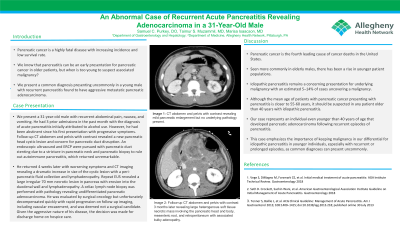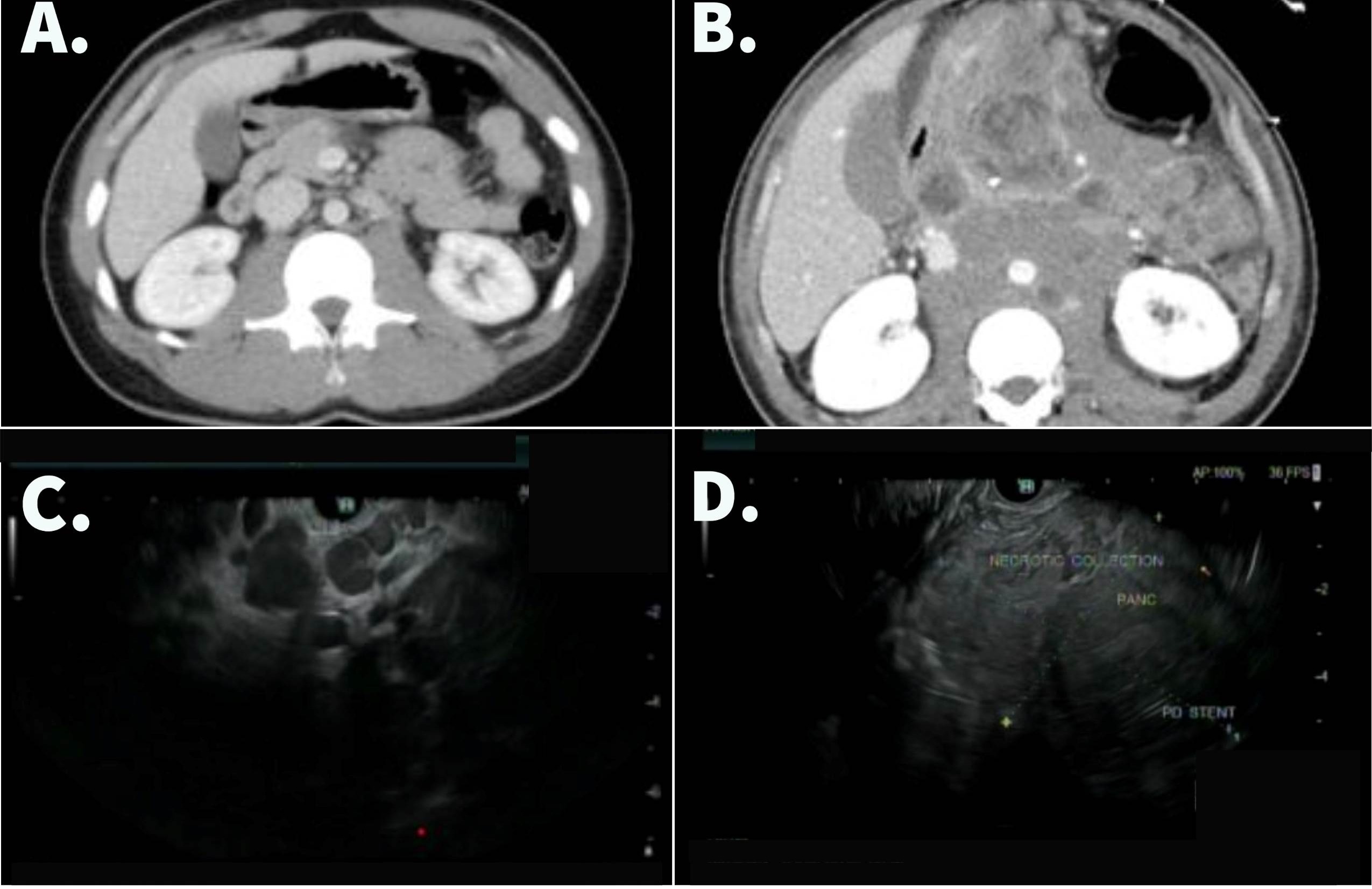Sunday Poster Session
Category: Biliary/Pancreas
P0115 - An Abnormal Case of Recurrent Acute Pancreatitis Revealing Adenocarcinoma in a 31-Year-Old Male
Sunday, October 22, 2023
3:30 PM - 7:00 PM PT
Location: Exhibit Hall

Has Audio

Samuel Purkey, DO
Allegheny Health Network
Pittsburgh, PA
Presenting Author(s)
Samuel Purkey, DO, Taimur S. Muzammil, MD, Marisa Isaacson, MD
Allegheny Health Network, Pittsburgh, PA
Introduction: Pancreatic cancer is a highly fatal disease with increasing incidence and low survival rate. We know that pancreatitis can be an early presentation for pancreatic cancer in older patients, but when is too young to suspect associated malignancy? We present a common diagnosis presenting uncommonly in a young male with recurrent pancreatitis found to have aggressive metastatic pancreatic adenocarcinoma.
Case Description/Methods: We present a 31-year-old male with recurrent abdominal pain, nausea, and vomiting. He had 3 prior admissions in the past month with the diagnosis of acute pancreatitis initially attributed to alcohol use. However, he had been abstinent since his first presentation with progressive symptoms. Follow-up CT abdomen and pelvis with contrast revealed a new pancreatic head cystic lesion and concern for pancreatic duct disruption. An endoscopic ultrasound and ERCP were pursued with pancreatic duct stenting due to a stricture in pancreatic neck and pancreatic biopsy to rule out autoimmune pancreatitis, which returned unremarkable.
He returned 4 weeks later with worsening symptoms and CT imaging revealing a dramatic increase in size of the cystic lesion with a peri-pancreatic fluid collection and lymphadenopathy. Repeat EUS revealed a large irregular 70 mm necrotic lesion in pancreas with erosion into the duodenal wall and lymphadenopathy. A celiac lymph node biopsy was performed with pathology revealing undifferentiated pancreatic adenocarcinoma. He was evaluated by surgical oncology but unfortunately decompensated quickly with rapid progression on follow-up imaging, including vascular encasement, and was deemed not a surgical candidate. Given the aggressive nature of his disease, the decision was made for discharge home on hospice care.
Discussion: Pancreatic cancer is the fourth leading cause of cancer deaths in the United States. Seen more commonly in elderly males, there has been a rise in younger patient populations. Idiopathic pancreatitis remains a concerning presentation for underlying malignancy with an estimated 5–14% of cases uncovering a malignancy. Although the mean age of patients with pancreatic cancer presenting with pancreatitis is closer to 55-60 years, it should be suspected in any patient older than 40 years with idiopathic pancreatitis. This case emphasizes the importance of keeping malignancy in our differential for idiopathic pancreatitis in younger individuals, especially with recurrent or prolonged episodes, as common diagnoses can present uncommonly.

Disclosures:
Samuel Purkey, DO, Taimur S. Muzammil, MD, Marisa Isaacson, MD. P0115 - An Abnormal Case of Recurrent Acute Pancreatitis Revealing Adenocarcinoma in a 31-Year-Old Male, ACG 2023 Annual Scientific Meeting Abstracts. Vancouver, BC, Canada: American College of Gastroenterology.
Allegheny Health Network, Pittsburgh, PA
Introduction: Pancreatic cancer is a highly fatal disease with increasing incidence and low survival rate. We know that pancreatitis can be an early presentation for pancreatic cancer in older patients, but when is too young to suspect associated malignancy? We present a common diagnosis presenting uncommonly in a young male with recurrent pancreatitis found to have aggressive metastatic pancreatic adenocarcinoma.
Case Description/Methods: We present a 31-year-old male with recurrent abdominal pain, nausea, and vomiting. He had 3 prior admissions in the past month with the diagnosis of acute pancreatitis initially attributed to alcohol use. However, he had been abstinent since his first presentation with progressive symptoms. Follow-up CT abdomen and pelvis with contrast revealed a new pancreatic head cystic lesion and concern for pancreatic duct disruption. An endoscopic ultrasound and ERCP were pursued with pancreatic duct stenting due to a stricture in pancreatic neck and pancreatic biopsy to rule out autoimmune pancreatitis, which returned unremarkable.
He returned 4 weeks later with worsening symptoms and CT imaging revealing a dramatic increase in size of the cystic lesion with a peri-pancreatic fluid collection and lymphadenopathy. Repeat EUS revealed a large irregular 70 mm necrotic lesion in pancreas with erosion into the duodenal wall and lymphadenopathy. A celiac lymph node biopsy was performed with pathology revealing undifferentiated pancreatic adenocarcinoma. He was evaluated by surgical oncology but unfortunately decompensated quickly with rapid progression on follow-up imaging, including vascular encasement, and was deemed not a surgical candidate. Given the aggressive nature of his disease, the decision was made for discharge home on hospice care.
Discussion: Pancreatic cancer is the fourth leading cause of cancer deaths in the United States. Seen more commonly in elderly males, there has been a rise in younger patient populations. Idiopathic pancreatitis remains a concerning presentation for underlying malignancy with an estimated 5–14% of cases uncovering a malignancy. Although the mean age of patients with pancreatic cancer presenting with pancreatitis is closer to 55-60 years, it should be suspected in any patient older than 40 years with idiopathic pancreatitis. This case emphasizes the importance of keeping malignancy in our differential for idiopathic pancreatitis in younger individuals, especially with recurrent or prolonged episodes, as common diagnoses can present uncommonly.

Figure: A: CT abdomen and pelvis with contrast revealing mild pancreatic enlargement but no underlying pathology present.
B: Follow-up CT abdomen and pelvis with contrast 3 months later revealing large heterogenous soft tissue necrotic mass involving the pancreatic head and body, mesenteric root, and retroperitoneum with associated bulky adenopathy.
C: Endoscopic ultrasound imaging revealing extensive bulky lymphadenopathy at the celiac region.
D: Endoscopic ultrasound imaging revealing an irregular hypoechoic mass consistent with large area of necrosis within the pancreatic body measuring 75 mm by 58 mm in maximal cross-sectional diameter.
B: Follow-up CT abdomen and pelvis with contrast 3 months later revealing large heterogenous soft tissue necrotic mass involving the pancreatic head and body, mesenteric root, and retroperitoneum with associated bulky adenopathy.
C: Endoscopic ultrasound imaging revealing extensive bulky lymphadenopathy at the celiac region.
D: Endoscopic ultrasound imaging revealing an irregular hypoechoic mass consistent with large area of necrosis within the pancreatic body measuring 75 mm by 58 mm in maximal cross-sectional diameter.
Disclosures:
Samuel Purkey indicated no relevant financial relationships.
Taimur Muzammil indicated no relevant financial relationships.
Marisa Isaacson indicated no relevant financial relationships.
Samuel Purkey, DO, Taimur S. Muzammil, MD, Marisa Isaacson, MD. P0115 - An Abnormal Case of Recurrent Acute Pancreatitis Revealing Adenocarcinoma in a 31-Year-Old Male, ACG 2023 Annual Scientific Meeting Abstracts. Vancouver, BC, Canada: American College of Gastroenterology.
